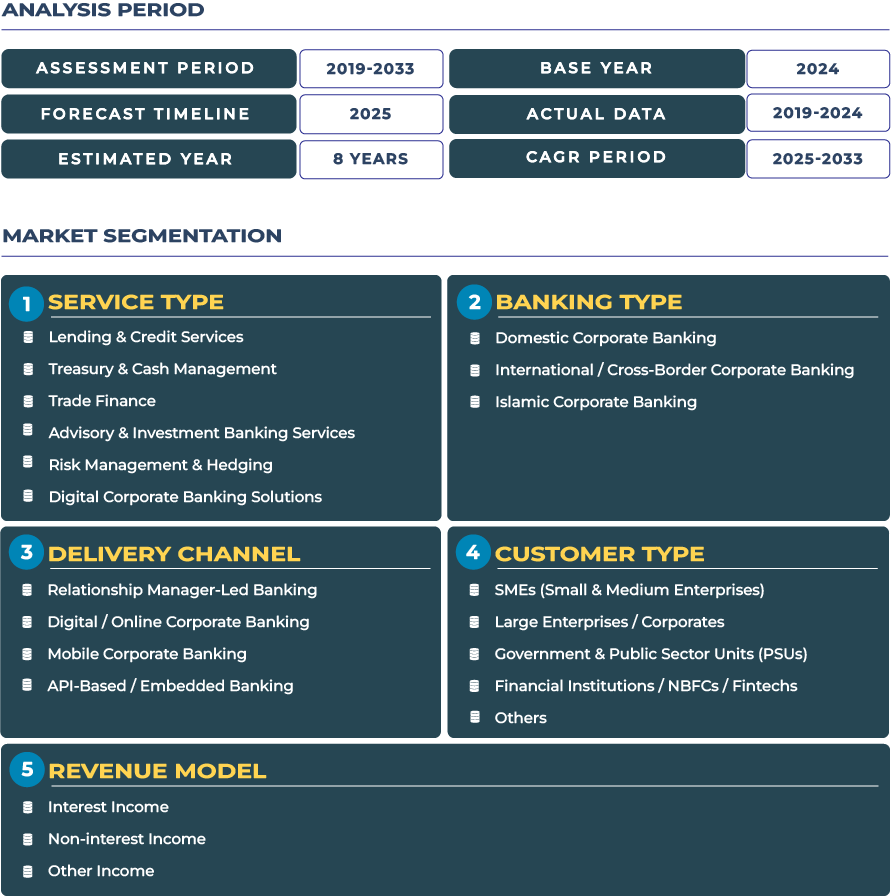Digital Transformation in Corporate Banking: How North American Banks Are Leveraging AI and Fintech for SMEs and Enterprises
The North America Corporate Banking Market is undergoing a decisive shift, driven by advanced digitalization and fintech partnerships aimed at enhancing SME and enterprise services. As corporations navigate complex supply chains, liquidity pressures, and global transaction flows, banks across the US, Canada, and Mexico are embracing AI, cloud computing, and embedded finance solutions to modernize operations. The regional market, valued at USD 572.8 billion in 2025, is projected to reach USD 691.0 billion by 2033, expanding at a CAGR of 2.4%. This steady growth reflects how the corporate banking ecosystem is leveraging technological innovation to address treasury optimization, risk management, and digital lending demands across diverse corporate segments.
North America Corporate Banking Market Outlook: Corporate Banking Redefined Through Technology and Trust
North American corporate banks are transitioning from transactional service providers to strategic digital partners. The integration of AI-based credit scoring, real-time treasury dashboards, and cloud-native platforms has enhanced operational agility for both multinational enterprises and mid-market firms. Banks such as J.P. Morgan and Bank of America are leading this shift by embedding fintech-driven solutions that enhance corporate payments and liquidity visibility. Rising demand for sustainable finance, combined with the need for regulatory compliance and cyber resilience, continues to reshape corporate banking strategies. The region’s strong fintech ecosystem, coupled with regulatory clarity from institutions like the U.S. Federal Reserve and Office of the Superintendent of Financial Institutions (OSFI), positions North America as a benchmark for digital transformation in global corporate banking.
Drivers & Restraints: Digital Liquidity and Structural Challenges in Corporate Banking
Liquidity Optimization and Embedded Payment Innovations Power Market Momentum
A significant growth driver in the North America corporate banking industry is the increasing focus on liquidity optimization and embedded payments. Large enterprises are seeking real-time insights into their cash positions, leading banks to deploy AI-driven treasury solutions and cloud-based cash management systems. The surge in cross-border trade and supply-chain financing, especially in manufacturing and technology sectors, has accelerated demand for sophisticated payment APIs and digital treasury integration. Moreover, the growth of nearshoring between the U.S. and Mexico has boosted trade finance and structured credit demand, enabling banks to offer dynamic discounting and receivables financing tools aligned with corporate cash flow needs.
Legacy Systems, Compliance Pressures, and Concentration Risks Hampering Scalability
Despite its technological edge, the North American corporate banking landscape faces constraints from legacy infrastructure and complex compliance frameworks. Mid-tier banks often struggle to integrate legacy systems with modern API architectures, hindering digital scalability. Additionally, stringent anti-money laundering (AML) regulations and rising costs of compliance with frameworks like the FINTRAC reporting standards elevate operational burdens. The concentration of corporate lending among top-tier banks further increases systemic risk and reduces competitive agility. This fragmentation underscores the need for modernization initiatives and open banking protocols that enable greater interoperability across institutional platforms.
Trends & Opportunities: Shaping the Future of North American Corporate Banking
Real-Time Payments and API Banking: The New Corporate Connectivity Standard
One of the most defining trends is the widespread adoption of real-time payments and API-driven connectivity. As corporates demand seamless integration between ERP systems and bank accounts, institutions are prioritizing open banking APIs to deliver instant reconciliation and payment visibility. In the U.S., the introduction of the Federal Reserve’s FedNow Service in 2023 has catalyzed real-time transaction adoption, fostering greater liquidity management precision for corporate clients. Canadian and Mexican banks are following similar paths, embedding fintech innovations to offer intelligent, multi-currency treasury solutions that reduce latency and operational inefficiencies.
ESG-Linked Financing and Digital Treasury Platforms Driving Growth Opportunities
The push toward sustainability and green finance is opening new revenue channels for corporate banks in North America. ESG-linked lending products and sustainability-indexed syndicated loans are rapidly gaining traction among large enterprises. Additionally, banks are developing SME-focused digital treasury platforms that enable better liquidity tracking and financial forecasting. The rise of supply-chain finance solutions tailored for nearshoring manufacturers in Mexico and Canada provides further opportunities. These developments align with North America’s broader economic shift toward responsible and technology-driven corporate finance ecosystems.
Regional Analysis by Country
-
United States Corporate Banking Market
The U.S. remains the cornerstone of North America corporate banking landscape, with digital transformation leading the agenda. American banks are leveraging fintech alliances to modernize corporate lending, trade finance, and risk management functions. The implementation of real-time payment systems and AI-driven credit evaluation tools has enhanced capital allocation efficiency for enterprises.
-
Canada Corporate Banking Market
Canada corporate banking sector is expanding through digitization and sustainability-focused offerings. With supportive regulation from OSFI and growing fintech collaboration, Canadian banks are integrating ESG-linked financing and digital treasury solutions to cater to corporate clients’ evolving needs in trade and cross-border liquidity management.
-
Mexico Corporate Banking Market
Mexico corporate banking industry is benefiting from nearshoring-led trade expansion. Local banks are adopting fintech-based trade finance and supply-chain funding models to meet rising manufacturing and logistics financing demand. Increased collaboration with U.S. corporates is driving innovation in cross-border payment solutions and working capital optimization.
Competitive Landscape: Strategic Partnerships, Modular Treasury, and ESG Innovation
The North American corporate banking sector is marked by increasing collaboration between traditional financial institutions and fintech startups. Leading banks like Citi and Wells Fargo are rolling out modular treasury platforms and ESG-linked working capital finance tools to meet evolving enterprise demands. In 2024, Citi expanded its “Treasury and Trade Solutions” across North America, integrating cloud-native APIs for real-time liquidity monitoring. Similarly, Bank of America launched its ESG-linked lending program to align corporate clients’ financing with sustainability goals. These initiatives underscore a broader trend where partnership-driven innovation accelerates corporate banking digitization, balancing profitability with purpose-driven banking.








